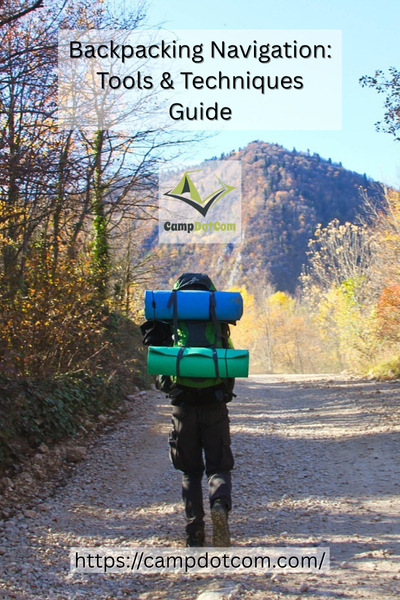Ever been halfway up a mountain trail thinking you are on the right path only to realize you have somehow ended up back where you started? I have been there and trust me, realizing you have been walking in a big circle is a special kind of frustrating.
That is exactly why this backpacking navigation guide is something I wish I had from the very start. Whether you are a weekend warrior or planning multi day treks, knowing where you are going and how to get back is really important.
So let us dive into how to navigate out there without turning your hike into an accidental off grid survival story.
As an Amazon Associate, I earn from qualifying purchases. Some of the links in this article are affiliate links. This means that, at zero cost to you, I will earn an affiliate commission if you click through the link and finalize a purchase.
Read More About Backpacking Navigation

Why Navigation Isn’t Just for Hardcore Adventurers
Look, I get it. Not everyone’s out here trying to be the next Bear Grylls. But you don’t need to be hanging off a cliff face or hacking through dense jungle to need solid navigation skills.
Even well-marked trails can get tricky when weather rolls in, your phone dies, or that signpost mysteriously vanishes.
More Things to Know About Backpacking Navigation

This backpacking navigation isn’t just for the pros. It’s for you and me—the folks who love the outdoors but also really, really like getting home in one piece.
Old-School Tools That Still Totally Work
First up, maps and compasses. I know, I know, it sounds like something your grandpa used on his way to school, uphill both ways. But trust me, when your GPS app stops working or you find yourself in a no signal area, that old fashioned paper map will feel like a superhero cape.
I carry a topographic map of wherever I’m headed and a simple compass. No batteries. No drama. It’s like my backup plan’s backup plan.
I once ended up completely off-trail during a solo hike in Colorado. GPS signal dropped faster than my phone battery, and clouds rolled in. Pulled out my compass and map, figured out which direction the trail should be, and eventually found a junction sign that matched up. I’m not saying I cried when I saw it—but I might’ve teared up a little. Navigation win.
Tech That’ll Have Your Back (When It Works)
Now, I love gadgets as much as the next gear junkie. GPS devices, smartwatches, and navigation apps are great when they work. Gaia GPS, AllTrails, and Garmin handhelds are all solid choices for tracking your route and marking waypoints.
But here’s the kicker: don’t only rely on tech. This backpacking navigation is all about layering your strategies. Use tech when it’s handy, but always have a physical backup. Because Murphy’s Law loves to hike, too.
Pro tip: download maps before you go. No signal equals no streaming trail maps.
Understanding the Terrain (So You Don’t Walk Into a Ravine)
One part of navigation that people often forget is simply reading the landscape. Those wavy lines on a topo map are not just for decoration. They actually show you where the mountains, valleys, and ridges are.
Take a moment before you start hiking to study the map and pick out natural markers. That ridge to the east could be your guide. The lake you passed a couple of miles back? Perfect. Now you have a landmark to work with.
Sometimes it is not about knowing your exact location. It is about knowing where you definitely are not. That can be just as useful when you are trying to figure out which direction to go.
Route Planning = Sanity Saver
Let’s talk about planning. You don’t need a military-style mission briefing, but mapping your route beforehand helps. Plot your start and end points, note any water sources, tricky trail forks, or places you want to stop for a snack (priorities!).
Leave a copy of your route with a friend or loved one, too. That way, if something does go sideways, someone else knows where to start looking.
Little Tricks That Make a Big Difference
Here’s where it gets fun. Want some quick wins?
- Use trail markers and blazes—those colorful little stripes on trees? They’re not just for decoration.
- Pay attention to your surroundings when you set out. Make a mental note (or take a quick photo) of the trailhead and major junctions.
- Turn around occasionally and look at the trail from the other direction. Everything looks different on the way back.
Master the Trail with This Backpacking Navigation and Never Lose Your Way Again
If you have made it this far, nice work. You are now more navigation savvy than most casual hikers out there. These backpacking navigation tips are not about turning you into an expert overnight. They are here to help you feel more confident, equipped, and ready to enjoy the journey safely.
Navigation does not need to feel scary. It is a skill you build step by step. And yes, you will make mistakes sometimes. I still do. That is all part of the learning process.
So next time you lace up your boots and head into the great unknown, you will have your map, your compass, maybe a GPS, and a lot more confidence to guide you.
And if you ever find yourself halfway up a trail thinking, “Wait, have I seen this tree before?”—now you will know just what to do.
